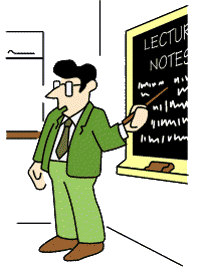Using Punctuation Marks
Punctuation is the use of standard marks and signs in writing to separate words into sentences, clauses, and phrases in order to clarify meaning. The marks or signs are called punctuation marks. Punctuation marks are signals to readers. When you speak, you can pause, stop, or change your tone of voice to make your meaning clear. You cannot do this when you write. When writing, you must use punctuation marks such as commas and question marks to make your meaning clear.
The use of punctuation marks can be very complex. Each punctuation mark can be used in many ways. Here are the punctuation marks that are most commonly used when writing and the most typical way or ways they are used.
Examples are provided for each.
 Period (.)
Period (.)
– Use a period at the end of a declarative sentence (a sentence which states an idea).
“That was a wonderful movie.”
– Use a period to end an abbreviation.
“I think that Mr. Williams is a great teacher.”
Question Mark (?)
– Use a question mark at the end of an interrogative sentence (a sentence which asks a question).
“Did you like that movie?”
Comma (,)
– Use a comma to separate three or more items in a series.
“My history class meets each Monday, Wednesday, and Friday.”
– Use a comma to separate independent clauses in a sentence.
“We wanted to go to the beach, but it rained that day.”
– Use a comma after introductory words or phrases in a sentence.
“Certainly, I have my homework right here.”
– Use a comma to set off dates and addresses.
“My friend Jane, who was born June 18, 1992, lives in Akron, Ohio.”
 Semicolon (;)
Semicolon (;)
– Use a semicolon when two independent clauses in a sentence are not connected by a conjunction (such as “and”).
“I like pizza; Carlos also likes pizza”
– Use a semicolon between independent clauses in a sentence that are connected by any of the following transitional words or phrases: accordingly, consequently, for example, for instance, furthermore, however, instead, moreover, nevertheless, otherwise, and therefore.
“I planned to study Saturday morning; however, the power in our house went out due to a storm.”
– Use a semicolon when the items in a series of items contain commas.
“I have lived in Los Angeles, California; Boston, Massachusetts; Trenton, New Jersey; and Philadelphia, Pennsylvania.”
Colon (:)
– Use a colon before a list that is preceded by a complete independent clause. Some form of the word “follow” is often used in such a case.
“On our next vacation, we plan to visit the following countries: England, France, Italy, and Greece.”
– Use a colon to divide hours from minutes.
“I have an appointment with the doctor at 10:30 tomorrow morning.”
Exclamation Point (!) (sometimes called an Exclamation Mark)
– Use an exclamation mark at the end of a sentence to show strong emotion.
“I am very upset with him!”
– Use an exclamation mark at the end of a sentence for emphasis.
“I have to go home right now!”
– Use an exclamation mark after an interjection at the start of a sentence (an interjection is a word used to express strong feeling or sudden emotion).
“Wow! That test was harder than I expected.”
 Apostrophe (‘)
Apostrophe (‘)
– Use an apostrophe to indicate a missing letter or letters in a contraction.
“I don’t think she will win the election.”
– Use an apostrophe plus the letter “s” to show possession.
“Please take good care of Brad’s dog.”
Use punctuation marks to make the meaning of what you write as clear as possible.
